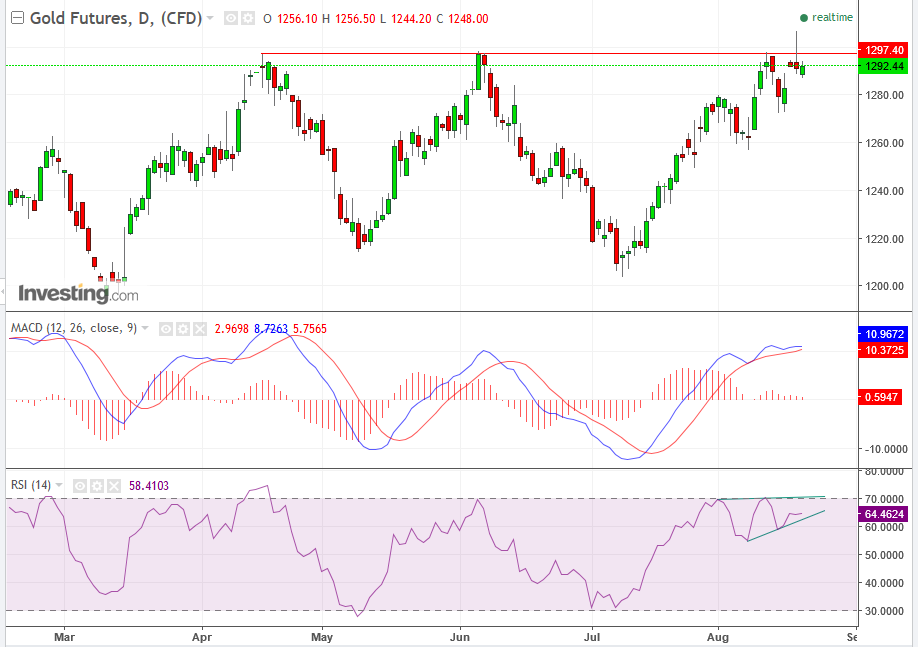By Pinchas Cohen
Gold’s value is derived from its haven status more than any other fundamental principle. This is for the natural fact that professional gold investors are a relatively small group, but when risk-off dominates the market, hedgers, investors, traders and speculators of all kinds trade contracts on the physical metal.
After all the volatility last week, it may surprise readers to know that gold actually declined last week on a weekly basis by 80 cents. Why did it not rise in reaction to the stock-market selloff? Well, first, it’s more closely correlated to the dollar. The US currency actually rose 0.4 percent. How is that possible, after yet another political scandal in what’s becoming a chain of weak links to any business agenda that might help the dollar? The reason is relief of a diplomatic ceasefire between North Korea and the US.
While the dollar took a hit, paring 0.75 percent of last week’s gain, it still held on to a 0.4 percent gain, after investors emitted a sigh of relief.
On Friday, gold advanced over the $1,300 level for the first time since November 9, when investors found out that Donald Trump would be president and didn’t know what to do with that information. On that date, it only took 3 hours for everything to turn on its head. The havens were sold off in favor of stocks, Treasuries and the dollar, all of which climbed more than they have in years.

However, President Donald Trump has yet to embark upon his business agenda, which compounded by his anti-dollar rhetoric caused a dollar selloff, which was extended by weak inflation. The dollar selloff caused gold to bottom from its December 15 low of $1,123.90, which erased 18 of the 29 percent gain of the year.
Since then, the price has been trading within $1,200 and $1,300. Friday’s advance over the $1,300 couldn’t hold and it closed sharply below it as well as below its opening price. This formed a bearish Shooting Star with an exceptionally long upper shadow. The bears saw the advance and said, “This is bull!” and pushed them all the way back, and then some.
The dollar will probably trade in a holding pattern until investors hear what central bankers have to say at the Jackson Hole, Wyoming summit, starting on Thursday. Therefore – pending any saber rattling or acts of terror – gold will probably hover in place as well.
The fact that the price stopped at the $1,300 resistance confirms its significance. The RSI is consolidating right below the 70-oversold level in correspondence to the price consolidation beneath its resistance.
From a risk-reward perspective, a short would provide a $9.5 risk to the top of Friday’s shooting star at $1,306.90 and a potentially $95 reward to the $1,200 levels, providing a 10:1 extraordinarily favorable risk-reward ratio. Of course, should the price close above the shooting star, a reversal would be called, but for now, the trajectory is to stay within its pattern.
Trading Strategies
Conservative traders may wait on a short for an upward correction toward the $1,307 resistance of the shooting star.
Moderate traders may wait on a short for an upward correction toward the $1,300 psychological resistance.
Aggressive traders may short, with an advisable, minimum stop-loss above $1,299.00, which is the highest the price reached this year, with the exception of the shooting star intra-day high.
Risk-Reward Ratio
Traders should only enter trade which affords them a minimum of 3:1 risk-reward ratio, which means for every amount they risk, they should allow the chance to earn at least three times that much. Traders need to cover losses, before they can consider a win a profit. A common mistake among traders is running with their losses and cutting their wins, when they should do the opposite, if they want a chance to survive. This risk-reward ratio will help. Therefore, whatever the risk with the stop-loss, do not exit the trade before you have made at least 3 times as much as the risk.
